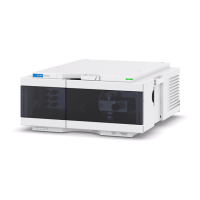Agilent 1260 Infinity RID User Manual 87
Optimizing the Refractive Index Detector
5
Refractive Index Detector Optimization
Detector Equilibration
The Refractive Index (RI) is a function of temperature, pressure and a
property of the used solvent (it changes with solvent composition, degassing
level and due to any trace of contamination). Therefore the Refractive Index
Detector will detect any change in any of these parameters as a change in its
signal and a variation of its baseline. Therefore the detector will trace down
any instabilities in the system and the environment as well. It may sometimes
appear, as if the detector itself was unstable or generating an unstable
baseline, where in fact, the detector is simply displaying the instabilities of the
environment and the rest of the system. By this the detector is often - without
justification - blamed for instabilities, which it does not generate itself, but
only detect. The fact that this detector is a universal detector makes it also
sensitive to instabilities introduced to it from outside the detector.
This makes it very important to have a very stable environment and system for
achieving best possible baseline stability. The baseline will get the better, the
longer the system is used under identical and stable conditions. Keep the
temperature in your laboratory and system constant and controlled. Ideally a
system with an RID should be used always with the same type of analysis
(stable solvent composition, temperature, flow rates, don’t switch the pump
off after analysis, instead just recycle solvents or at least reduce only the flow.
Switch valves and settings only when needed. Don’t expose the detector to
draft of air or to vibrations). A change of any of these parameters may require
a considerable amount of time for re-equilibration.

